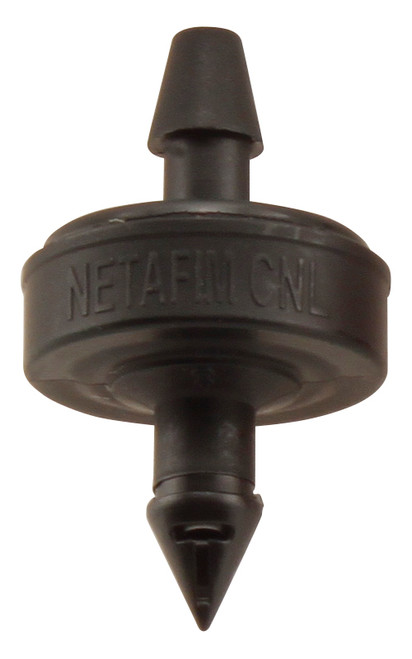Product Description
Netafim Woodpecker JR pressure compensated emitter 6.6 GPH with CNL - Barb to 3mm ID - Orange
For use with White PE 5mm OD / 3mm ID tubing
Best for use with Netafim pressure compensated spray stakes
APPLICATIONS
■ Greenhouses, nurseries, citrus.
■ Orchards, deciduous and tree irrigation. FEATURES AND BENEFITS
■ Pressure compensated: Precise and equal amounts of water are delivered over a broad pressure range. 100% uniformity of water and nutrient distribution along the laterals.
■ PCJ-LCNL & PCJ-HCNL with Anti-drain (LCNL & HCNL): Eliminates drainage and refill effect, and improves efficiency in pulse irrigation.
■ Continuously self flushing: Continuously flushing debris, throughout operation, not just at the beginning or end of a cycle, ensuring uninterrupted dripper operation.
■ TurboNet™ labyrinth assures wide water passages, large deep and wide cross section improves clogging resistance.
■ Dripper can be positioned exactly where required.
■ Number of drippers can be increased so as to increase water quantity supply aimed at meeting tree growth rate requirement.
■ Allows the installation of “spider assembly”, splitting the drip supply into a number of drip outlets. SPECIFICATIONS
■ Recommended filtration: 130 micron / 120 mesh. Filtration method is to be selected based on the kind and concentration of the dirt particles existing in the water. Wherever sand exceeding 2 ppm exists in the water, a Hydrocyclone is to be installed before the main filter. When sand/ silt/ clay solids exceed 100 ppm, pre treatment will be applied according to Netafim™ expert team’s instructions.
■ TurboNet™ labyrinth with large water passage.
■ To be “inserted” into thick-walled pipes (0.90, 1.00, 1.20 mm)
■ Injected dripper, very low CV.
■ 3 different outlets: nipple, barb to 3 mm ID and barb to 4 mm ID micro-tube.
■ High UV resistant. Resistant to standard nutrients used in agricultural.
■ PCJ on-line drippers meet ISO 9261 Standards with production certified by the Israel Standards Institute (SII).
Netafim offers several drippers with the CNL Check Valve feature for use in Greenhouse and Nursery applications such as Hanging Basket assemblies, Pressure Compensating Spray Stake assemblies, and Multi-Outlet Dripper assemblies. Drippers with the CNL feature include:
• Woodpecker Pressure Compensating Junior Drippers (WPCJ) with barbed outlet
• Woodpecker Pressure Compensating Junior Drippers (WPCJ) with nipple outlet
• Woodpecker Pressure Compensating Drippers (WPC) with nipple outlet

WPCJ Barbed Outlet WPC Nipple Outlet The following are factors to consider when using CNL drippers.
OPERATION
All Netafim CNL drippers are Pressure Compensating. Once the pressure reaches the specified regulating pressure range, the flow stays constant (within published ISO 9261 tolerances) while in the published pressure regulation range of pressures. The main feature of CNL drippers is that the irrigation lines and drippers stay full of water when the system is turned off (as long as the system elevation requirements for the specific CNL drippers are met - see applicable product technical sheets for the ‘closing’ pressure). The benefit of this is minimal-to-no start up travel time and minimal-to-no drainage when the system is turned off. This greatly increases water use efficiency and overall system delivery efficiency of water and nutrients to the plants being irrigated. All Netafim Pressure Compensating (PC) drippers with the CNL features use silicon diaphragm membranes to regulate the pressure.With any PC dripper, there are pH limitations that must be recognized in order not to damage the drippers for the long term and Netafim has specific guidelines to follow for pH limitations.
MAINTENANCE
CNL irrigation systems will require more maintenance than non-CNL systems as the environment inside the pipes is more susceptible to biological activity and general sediment build-up. This means that more flushing will be required than is normally done on other systems to clean the pipes of organics, biological growth and other coarse debris not captured by the filtration system. Netafim provides guidelines on several types of injection methods to use for maintenance of the drip irrigation system (see links below).
WINTERIZATION
In areas that experience freezing conditions, there are some extra precautions needed to properly protect the drippers to ensure their long-term care. Since the drippers are designed to close and hold water inside the pipes and inside the drippers, they are susceptible to potential damage if the environmental conditions in the pipes get to or below 32° F / 0° C. We recommend flushing the lines of water while also flushing with air so that you can ensure the drippers do not have water inside when the temperatures drop to freezing conditions (remember that water expands when it changes state from a liquid to a solid). This expansion property is what can damage the drippers as the water will need to go somewhere as it expands.










